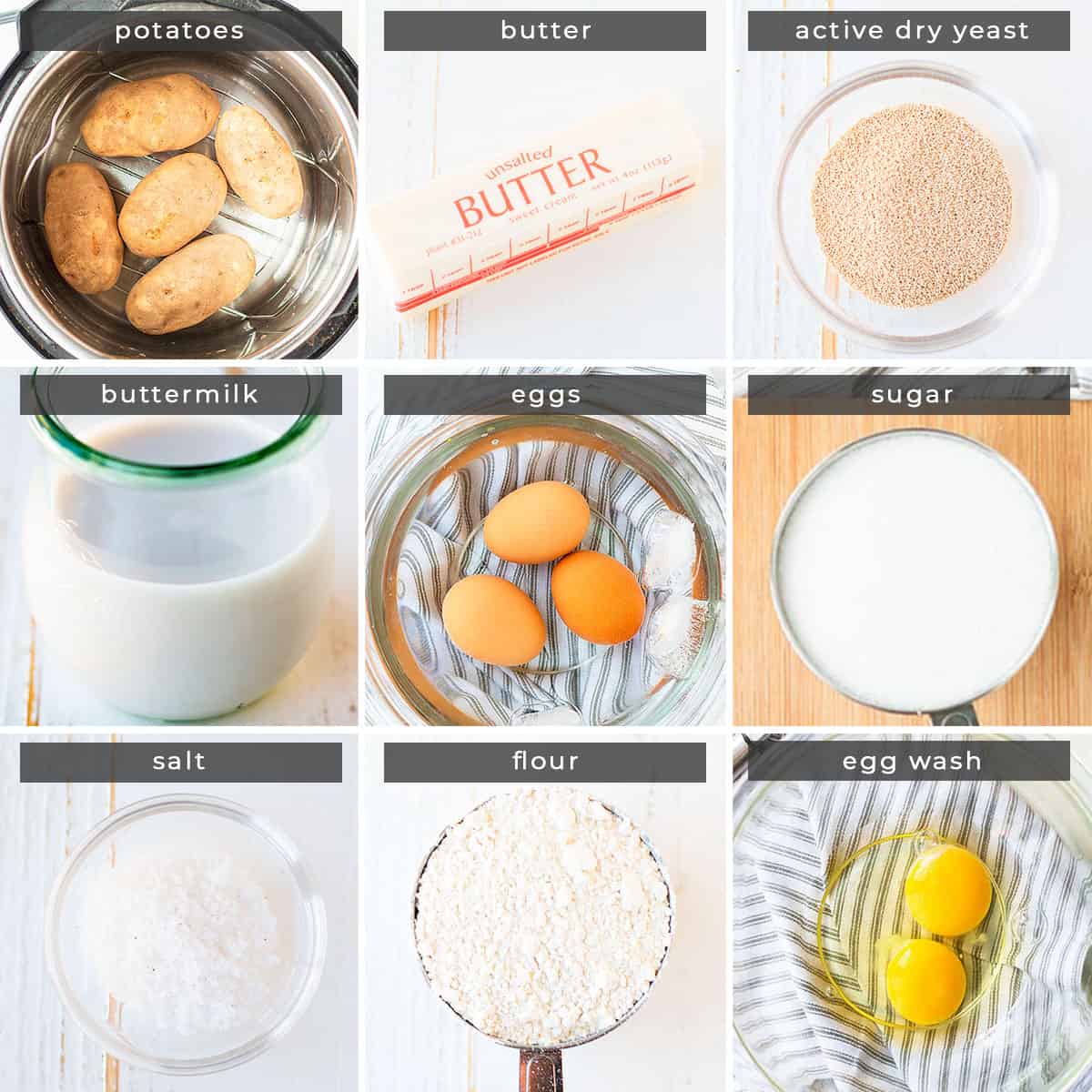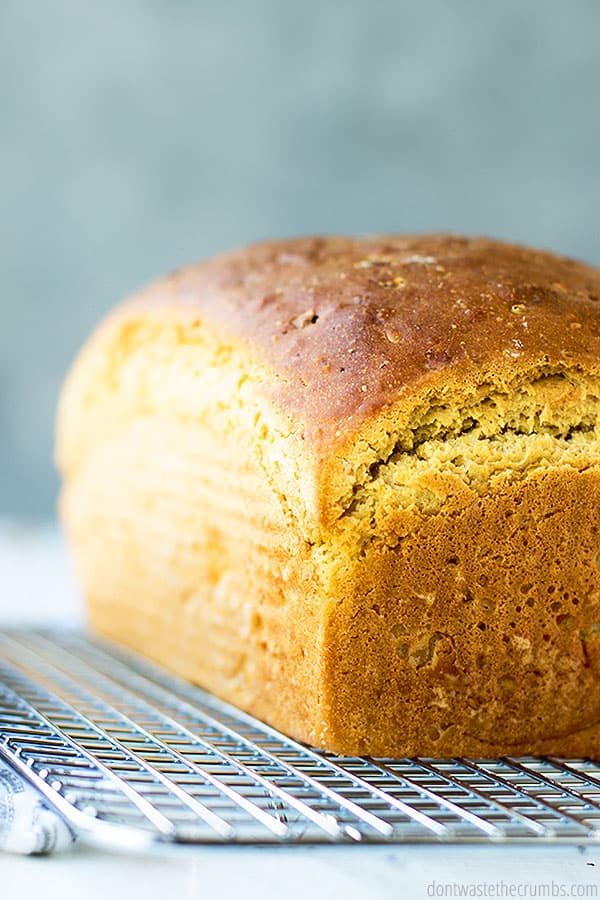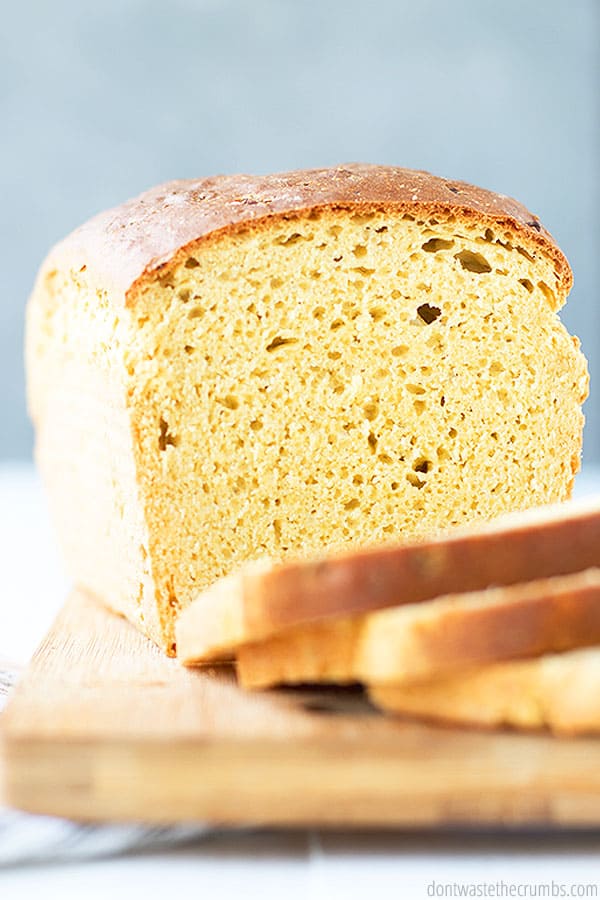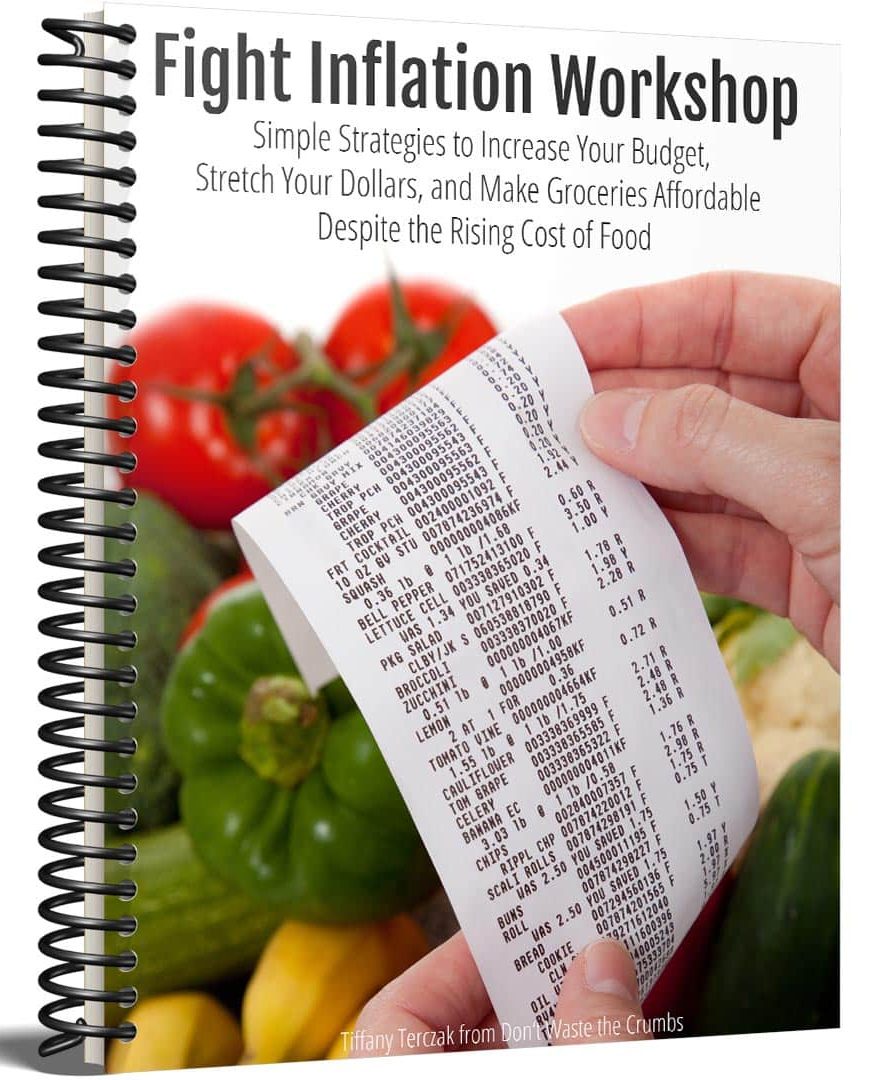This buttermilk potato bread recipe is a great way to use leftover mashed potatoes. It’s flavorful, moist, and fluffy on the inside with a golden-brown crust – perfect for sandwiches or toast!

I used to buy our bread at the store. But one day I ran out of bread, and I thought that it couldn’t possibly be that difficult to make. So, I attempted my first batch of homemade bread using an easy bread recipe like this one and while it was good, I wasn’t sure I wanted to keep making my own.
My second batch of homemade bread was this Potato Buttermilk Bread recipe. One slice and I was hooked! It was SO delicious and suddenly I didn’t mind the little bit of work that it took to make.
However, what SOLD me on never buying store-bought bread again was this:
Unbleached enriched wheat flour, buttermilk, sugar, yeast, soybean oil, salt, water, wheat gluten, calcium propionate, monoglycerides, calcium sulfate, citric acid, soy lecithin, calcium carbonate, datem.
In a single store-bought loaf of bread, there are more ingredients listed that I DON’T know than I DO know.
Since then, baking bread has been part of my regular routine. I‘ve made my No-Knead Overnight Artisan Bread, 90-Minute Man Bread, Oatmeal Bread, No-Yeast Bread, and even my Whole Wheat Einkorn Sourdough Bread…All of which I know you’ll love in addition to this amazing recipe for Buttermilk Potato Bread!
POTATO BUTTERMILK BREAD
Not only is this potato buttermilk bread recipe delicious, it’s also:
- Made of simple, easy-to-find ingredients
- Perfect for toast or sandwiches
- The most flavorful white bread ever
- Plus, it has a nice firm crust! YUM!

POTATO BREAD INGREDIENTS
- Russet Potatoes, peel removed and cut into large chunks (or use leftover mashed potatoes – see recipe tips below)
- Unsalted butter
- Buttermilk
- Eggs
- Sugar
- Salt
- Active dry yeast
- Bread flour (or all-purpose flour)
- Additional egg for egg wash
Psst! If you’re going to add salt, I highly recommend Ava Jane’s Kitchen. You may think all salt is created equal, but unfortunately, 90% of the salt produced around the world contains microplastics (gross, right?). Ava Jane’s Kitchen is an exception. Their salt is 100% microplastic-free, and it’s SO GOOD! Plus, you can get a free 8oz. bag of sea salt (just pay shipping and handling!)
INSTRUCTIONS HOW TO MAKE POTATO BREAD
Step 1: In a large saucepan, boil the potatoes until fork tender. Drain and either mash the potatoes in a large bowl with a potato ricer or potato masher or add the hot potatoes to a stand mixer and mix well with the butter. Alternatively, use 1 cup of leftover mashed potatoes. *
Step 2: Add buttermilk, 2 beaten eggs, sugar, salt, and yeast and mix well.
Step 3: Gradually stir in the bread flour in the bowl of a stand mixer until the dough is moist but not sticky. Knead with a dough hook on low to medium speed. Transfer to an oiled bowl, and cover with plastic wrap. Let the dough rise at room temperature until it is doubled in volume.

Step 4: When the dough has doubled in size, grease two 9 x 5 inch loaf pans. Punch the dough down, and divide it in half. On a lightly floured surface, form into two loaves. Place them seam-side down in the pans. Cover with plastic wrap and let the dough rise again at room temperature until almost doubled in size.
Step 5: Preheat oven to 375F. Brush the top of the loaves with the single beaten egg and bake the loaves until they are golden brown, about 40-45 minutes. Allow to cool on a wire rack for at least 30 minutes before serving.
*Note: Yeast wants a warm environment. If you’re making fresh hot potatoes for this recipe, add the ingredients in the order listed (the butter, buttermilk, and eggs will help cool the hot potatoes, so they do not kill the yeast). If you are using leftover mashed potatoes, warm the potatoes or the buttermilk first so that your mixture will be warm enough to activate the yeast.
POTATO BREAD RECIPE TIPS
If you have leftover mashed potatoes, you can use them for potato bread. This recipe calls for 2 potatoes, so the equivalent would be about 1 cup of mashed potatoes.
You can also freeze leftover mashed potatoes for future potato bread. Just thaw in the refrigerator before mixing up your bread dough.
To freeze buttermilk potato bread, wrap the bread loaves individually in plastic wrap and place them in freezer bags, or slice before freezing to easily pull out the amount of bread that you need.

TO SERVE POTATO BUTTERMILK BREAD
Cool the potato buttermilk bread for at least 30 minutes before slicing. Then dig in! Here are a few of my favorite ways to serve potato bread:
- Perfect for piling high with sliced turkey
- It also has the perfect spongy texture for spreading jam, butter, or nut butter because of all of the little nooks and crannies in it!
- Toast a thick slice, slather it with butter, and serve with The Best Scrambled Eggs for a yummy, easy breakfast.

BUTTERMILK POTATO BREAD FAQS
Can I use leftover mashed potatoes for homemade potato bread?
Yes, if you have leftover mashed potatoes, you can use them for potato bread. This recipe calls for 2 potatoes, so the equivalent would be about 1 cup of mashed potatoes.
Is potato bread gluten free?
As written, this potato bread recipe is not gluten-free, but you could try substituting the bread flour (or all-purpose) with gluten-free all-purpose flour.
What does homemade buttermilk potato bread taste like?
The flavor is so good that Mr. Crumbs asked me to make this instead of ever buying bread, which I think speaks mouthfuls. And it doesn’t taste like potatoes – they’re just there for the texture. This bread is light and spongy! Plus, the buttermilk makes it so moist and fluffy.
Hands down, this homemade bread is a winner. It’s just melt-in-your-mouth delicious!!
Why is potato bread yellow?
The mashed potatoes give potato bread its delightful yellowish hue!
MORE HOMEMADE BREAD RECIPES
- 90-Minute Man Bread
- No-Knead Overnight Artisan Bread
- Oatmeal Bread
- No-Yeast Bread
- Whole Wheat Einkorn Sourdough Bread
- Slow Cooker Bread
- Homemade Pita Bread

Fight Inflation Workshop!
Sign up for my FREE Fight Inflation Workshop and learn simple strategies to save money, even with rising food costs!Potato Buttermilk Bread
This buttermilk potato bread recipe is a great way to use leftover mashed potatoes. It’s flavorful, moist, and fluffy on the inside with a golden-brown crust – perfect for sandwiches or toast!
- Prep Time: 2 hours 30 minutes
- Cook Time: 45 minutes
- Total Time: 3 hours 15 minutes
- Yield: 2 loaves 1x
- Category: Breads
- Method: Oven
- Cuisine: American
Ingredients
- 2 potatoes, peeled and quartered
- 8 Tbsp unsalted butter, room temperature
- 4 tsp active dry yeast
- 2 cups buttermilk, room temperature
- 2 large eggs, slightly beaten
- 2 Tbsp sugar
- 1 ½ tsp salt
- 6 to 6 ½ cups of bread flour (or all-purpose flour)
- 1 egg, slightly beaten
Instructions
- Have all ingredients ready at room temperature. Bring a small to medium pot of water to a boil. Boil potatoes until done. Add hot potatoes and butter to a stand mixer and stir well.
- Add 4 tsp yeast + 2 cups buttermilk + 2 beaten eggs + 2 Tbsp sugar + 1 ½ tsp salt and mix well.
- Gradually stir in bread flour until the dough is moist but not sticky. Using the dough hook, knead on low to medium speed until the dough is smooth and elastic. Transfer to an oiled bowl and turn it over to coat with oil. Cover with plastic wrap and let the dough rise at room temperature until it’s doubled in volume, 1 to 1 ½ hours. (If your kitchen is too cold, you can preheat the oven to the lowest setting, then turn it off and place the dough inside.)
- When the dough has doubled in size, lightly grease two 9 x 5 inch loaf pans. Punch the dough down, divide it in half, and form into two loaves, placing them seam-side down in the pan. Cover with plastic wrap and let it rise again at room temperature until almost doubled in size, about 1 to 1 ½ hours. (If you don’t have loaf pans, you can free-form an artisan loaf on a cookie sheet).
- Preheat the oven to 375 degrees. Brush the top of the loaves with the single beaten egg and bake the loaves until they are golden brown and the bottoms sound hollow when thumped, about 40-45 minutes. Allow to cool for at least 30 minutes before serving.
- Bread can be wrapped individually in freezer bags and stored for future enjoyment!
Notes
- If you have leftover mashed potatoes, you can use them for potato bread. This recipe calls for 2 potatoes, so the equivalent would be about 1 cup of mashed potatoes.
- You can also freeze leftover mashed potatoes for future potato bread. Just thaw in the refrigerator before mixing up your bread dough.
- To freeze buttermilk potato bread, wrap the bread loaves individually in plastic wrap and place them in freezer bags, or slice before freezing to easily pull out the amount of bread that you need.
Nutrition
- Serving Size: 1 slice
- Calories: 331








I read through the entire post with all comments and didn’t see you mention whether a whole grain flour could be used. I was thinking along the lines of freshly ground whole wheat or einkorn, perhaps sifted. Have you tried it? I’m desperately trying to avoid all white bread for health issues but this has got my mouth watering!
So…. Like two average size, waxy potatoes… not large baking potatoes I assume…?
Hi Rob,
Yes. If the potatoes were mashed, the equivalent would be about 1 cup mashed potatoes. So feel free to use whatever type of potato you have on hand, but about as much as would equal 1 cup mashed, which is about 2 average size potatoes (or 1 large, perhaps if that’s what you have). Does the 1 cup mashed potato reference help?
First time baking bread, have no strength in for kneading the bread. It perfect moist, yummy bread. I am GF and LF. Did not get upset stomach. I eat some everyday. And the family request me to make again, I did and it was delicious. There is no kneading on the bread, just following instruction. Give 5 stars. It will now be the bread in this household of women.
I too am GF/ LF diet. I made cinnamon rolls , bread stay very moist in the fridge. Make it weekly and also share with the neighbors. 5 stars Great for beginners. I used the temperature gauge on the hot potatoes that melted the butter. I made a mistake and wait too long on the poofing and it rose 7″ over the bread pan. Then when I took out oven it fell. Still done and delicious, Lesson learned.
Hello read your recipe and everyone’s response. Now you said you could use left over mashed mashed potatoes. Are these potatoes you have seasoned with salt and pepper, butter or milk to serve at a mea.?
It would be however your mashed potatoes are!
I made this recipe with one exception, I used instant potatoes as I didn’t have any fresh on hand. I used 1/2 the recipe to make slider rolls and the other 1/2 for a loaf. My great nephew has never had homemade bread before and now he says he doesn’t want store bought again. It turned out great. Took photos, but I don’t see anywhere to post them. Thank you for the recipe. It is a hit at my home.
Thank you so much for sharing, Cheryl! Your bread sounds wonderful.
I have a question, and hope you be gracious enough to reply.
Potato bread buttermilk milk bread recipe looks perfect fo what I want to make.
My question, may I substitute dehydrated potatoes for this recipe. ?
I truly appreciate your advice and, or, direction.
Sincerely,
Judith Liberman
Email: [email protected]
I haven’t tried that myself Judith, but if you reconstitute the dehydrated potatoes into mashed potatoes, I don’t see why it wouldn’t work!
I presume my comment did not get posted or I failed to hit submit; taking $1.50/2 is $.75 but onward to better things…there is dry buttermilk; I use it in everything that is like a bread; you can also, as above, use lemon and/or vinegar to get the same results…this may be better known as sour milk not buttermilk…there is a difference but heah if it works so much the better. Mom, now gone, God bless her, such a hard life trying to feed us and being dirt poor…if there were leftover mashed potatoes, (we only saw those if uncle brought a large bag to us), she used the leftovers in her bread…that is how I discovered potato bread and how yummy. Someone mentioned save the crumbs..indeed!!!! On an off note..I take left over chips of any kind, roll them into a fine coating mix and use it on whatever meats I am going to broil, bake or fry. Hint for safer/healthier body…avoid nitrates and nitrites like they are poison..they are.
Hi Tiffany, I do hope you see this, you posted this a long time ago. Your potato bread looks just fantastic! The color and so hole-y (spongey, in a delectable sense) and light. I want to make this so much. I am not not that experienced. Wondering how you measure your flour? A cup of flour can be anywhere from 4.25 oz to over 5 oz depending on how you add flour to the cup. Then over 6-1/2 cups that can be a big difference in the amount of flour used and final texture of the dough and the finished bread. Would you please give me an idea how you measure flour, fluff in the bag and gently spoon into cup and level or dip into bag and level? Or better yet how much weight of flour. Thank you so much!
Hi Smita! I scoop my flour in my measuring cup. I know that’s the “wrong” way, but it’s just the way I’ve always done it! For bread, always start with the smaller end of measurement for flour, then add more as needed until you reach the right texture. For this recipe, you want the dough to be tacky – meaning you can stick your finger into the dough and your finger comes back w/o any dough attached. There will be a slight indentation where your finger way. I hope this helps – enjoy the recipe!
I did make this bread! It made two huge loaves. I have two 10-1/2 inch loaf pans and the dough filled them and grew to make giant, high, fluffy loaves. The bread is delicious. I will be making this again and again for sure. My crumb was not as hole-y as yours. I will try again. Thank you for posting this recipe. 🙂 🙂
You’re very welcome Smita! Glad you enjoyed this recipe!
USE CULTURED buttermilk, and you can top it off with milk or cream to keep it going and it will lasts months. Ignore the date on the bottle, as long as it does not have mold it’s good. You see, cultured buttermilk is like sourdough starter, it’s a symbiotic culture of good bacteria and yeasts… if you feed it then it just keeps on going and stays good for months. If you see mold, or if it smells rotten (not sour but rotten) then throw it out. But otherwise, a half gallon just keeps on giving. Use 2 cups, add 2 cups of milk back to the jug, shake and put in fridge. This only works with CULTURED buttermilk but you can find it at most any store. How’s that for a budget friendly option. Milk is much cheaper than buttermilk, and so by topping it off you save a lot of money. Also, the culture in cultured buttermilk is pro-biotic and is the same as in yogurt, kefir etc so use it to make pancakes, breads, smoothies etc. You can look this up on line as well, “how to culture buttermilk”.
I just made this and it turned out amazing, so soft and delicious. We even tried it with some Brie cheese in the panini machine and it was incredible.
Only thing I modified was adding cream on top instead of egg and sprinkled some sesame seeds. So good. Thank you for the fantastic recipe, and I didn’t have to throw away all my leftover buttermilk 🙂
So glad you enjoyed it Nada!! Here’s a tip – the egg is to make the crust get that golden brown. Feel free to skip it altogether if you’re ever in a pinch! 😉
This definitely solved my problem, thanks!
Quick question. Are the potatoes cooled when you add the yeast? I would have thought the hot potatoes would kill the yeast. Looks delicious! Thanks!
Hi Fanny! Of that short list of ingredients (sugar/buttermilk/eggs, etc.) I add the yeast last, so that the butter and everything else can cool the potatoes… just in case. 😉